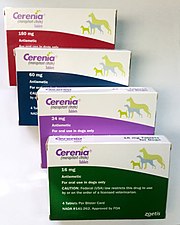User:Prof. Squirrel/sandbox
| For English X412-006 // by Persia Salehi |
 | |
| Clinical data | |
|---|---|
| Pronunciation | /məˈrɒpɪtænt/ mə-ROP-i-tant |
| Trade names | Cerenia |
| Other names | CJ-11,972 |
| AHFS/Drugs.com | FDA Professional Drug Information |
| License data | |
SQ, IV | |
| Drug class | Antiemetic |
| ATCvet code | |
| Legal status | |
| Legal status |
|
| Pharmacokinetic data | |
| Bioavailability | Oral: 20–30% dogs, 50% cats SQ: 90% (both) |
| Protein binding | 99.5% |
| Metabolism | Liver (CYP3A12 and CYP2D15) |
| Metabolites | CJ-18,518 |
| Elimination half-life | 6–8 hours (SQ) |
| Duration of action | 24 hours (SQ) |
| Identifiers | |
| |
JSmol) | |
| |
| |
Maropitant, sold as maropitant citrate under the brand name Cerenia by Zoetis, is a anti-nausea medication used in dogs and cats. Both the tablet and injectable versions were approved by the
Medical uses
Injectable maropitant is used in
Maropitant is effective in treating vomiting from a variety of causes, including
Maropitant has also been used in cases of acute episodes of rapid or labored breathing to prevent vomiting that could lead to aspiration pneumonia.[10] It has also been given in combination with a benzodiazepine to cats prior to stressful events (such as a vet visit) to possibly relieve hypersensitivity.[11]
When compared to other anti-emetics, maropitant has similar or greater effectiveness to
Maropitant has weak anti-inflammatory effects, and has thus been used as an adjunct treatment in severe
Maropitant is given
Contraindications
Maropitant is only indicated for dogs at least 16 weeks old, as some very young puppies suffered bone marrow hypoplasia (incomplete development ).[3] It should also not be used in animals with suspected GI obstruction or toxin ingestion.[8][13]
It is not recommended to give maropitant for more than five consecutive days, as it tends to accumulate in the body due to one of the liver enzymes responsible for its metabolism,
Because maropitant is metabolized by the liver, caution should be taken when giving it to dogs with
Side effects
Maropitant is safer than other antiemeticsused in veterinary medicine, in part because of its high specificity for its target and thus not binding to other receptors in the
One of the most common side effects of subcutaneous administration is moderate to severe pain at the injection site.
While there is no pain related to the intravenous administration of maropitant, pushing a dose in too quickly can temporarily reduce blood pressure.[5][13]
Fewer than 1 in 10,000 dogs and cats experience
Overdose
Signs of maropitant overdose include

Pharmacology
Mechanism of action
Vomiting is caused when impulses from the
Maropitant has a similar structure to

Pharmacokinetics
Maropitant's bioavailability is unaffected by the presence of food.[7] Bioavailability is 91% at the standard subcutaneous dose but 24% at the standard oral dose; the standard oral dose is higher to partially compensate for incomplete bioavailability.[3][13] It binds to plasma proteins at a rate of 99.5%; it has a low volume of distribution (9 L/kg) and is thus not extensively absorbed.[3][5] Subcutaneously administered maropitant had peak plasma concentration around half an hour after administration; the mean half-life is 6–8 hours, and a single dose lasts 24 hours in dogs.[5] Orally administered maropitant reached its peak plasma concentration within two hours.[7]
Maropitant undergoes
Maropitant clearance is slower in cats.[13]
References
- ^ a b "FDA Approves First Drug To Prevent and Treat Vomiting in Dogs". US Food & Drug Administration. 28 February 2007. Archived from the original on 2016-10-24. Retrieved 18 May 2018.
- ^ ISBN 978-1-118-85588-1.
- ^ a b c d e f g h "Cerenia". Drugs.com. Retrieved 27 March 2018.
- ^ "Cerenia Injectable Solution for Animal Use". Drugs.com. 29 March 2018. Retrieved 2 May 2018.
- ^ a b c d e f g h CVMP assessment report for Cerenia new route of administration (intravenous use) for the solution for injection (PDF) (Report). European Medicines Agency. 10 April 2015.
- ^ ISBN 978-0-7020-2858-8.
- ^ ISBN 978-0-470-95964-0.
- ^ ISBN 978-0-323-06876-5.
- ^ ISBN 978-1-118-52620-0.
- ^ a b Tamborini, Alice (November 2016). "Maropitant & Canine Chronic Bronchitis" (PDF). Clinician's Brief. Retrieved 29 March 2018.
- ^ ISBN 978-1-4557-7402-9.
- ^ ISBN 978-1-4377-0282-8.
- ^ a b c d e f g h Trepanier, Lauren A. (February 2015). "Maropitant: Novel Antiemetic" (PDF). Clinician's Brief. Retrieved 28 March 2018.
- PMID 28844293.
- ^ ISSN 1557-5063.
- OCLC 903234097.
- ^ a b "Contra-indications, warnings, etc". NOAH Compendium. National Office of Animal Health. Retrieved 11 May 2018.
- ^ Bahri, Lotfi. "Maropitant: A novel treatment for acute vomiting in dogs". dvm360.com. Retrieved 28 March 2018.
- ^ a b Graham, Heather (June 2013). "Motion Sickness in Small Animals: Pathophysiology & Treatment". Clinician's Brief. Retrieved 29 March 2018.
- ^ a b Bahri, Lotfi (1 September 2009). "Maropitant's pharmacokinetics and pharmacology". dvm360. Retrieved 2 May 2018.
- ISBN 978-0-323-24300-1.
